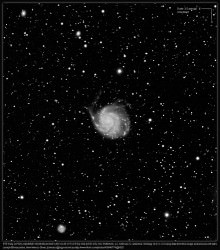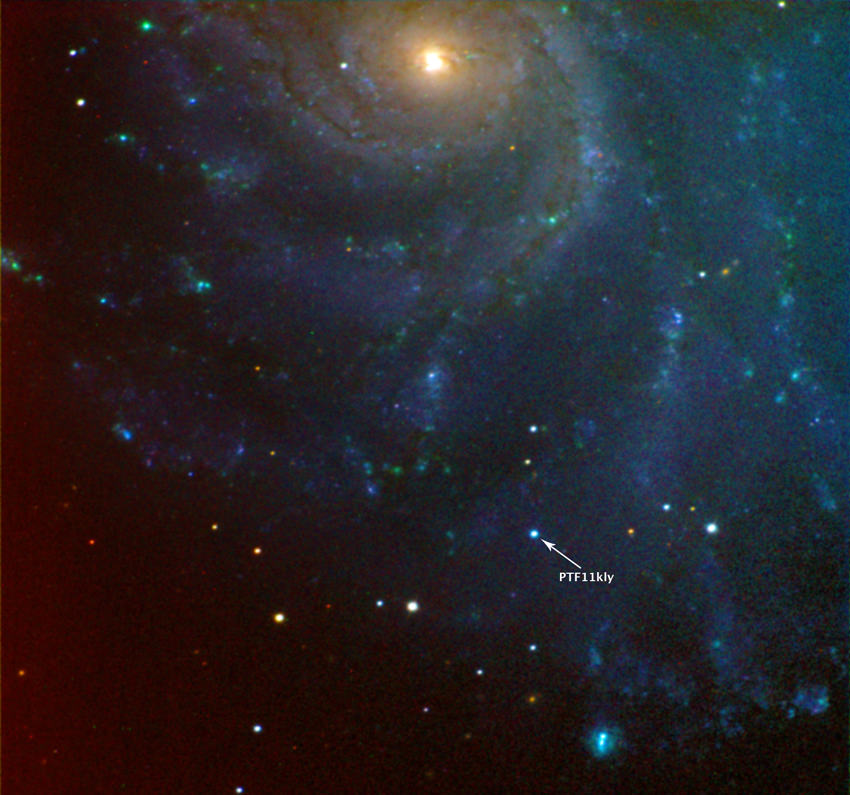[/caption]
Literally an event of stellar proportions, a new Type Ia supernova has been identified in a spiral galaxy 25 million light-years away! Spotted by Caltech’s Palomar Transit Factory project, this supernova, categorized as PTF11kly, is located 58″.6 west and 270″.7 south of the center of M101. It was first seen yesterday, August 24, 2011.
According to AAVSO Special Notice #250 P. Nugent et al. reported in Astronomical Telegram #3581 that a possible Type-Ia supernova has been discovered by the Palomar Transient Factory shortly after eruption in the galaxy M101 and has been designated “PTF11kly”. The object is currently at a magnitude of 17.2, but may well rise by several magnitudes. The object is well placed within M101 for good photometry, and observations of this potential bright SNIa are strongly encouraged.
There are currently no comparison stars available in VSP for this field; please indicate clearly the comparison stars that you use for photometry when reporting observations to AAVSO. Please retain your images and/or photometry for recalibration when comparison star magnitudes are available.
Need coordinates? The (J2000) coordinates reported for the object are RA: 14:03:05.81 , Dec: +54:16:25.4. Messier 101 is located in the constellation of Ursa Major at RA: 14h 03m 12.6s Dec: +54 20′ 57″
Charts for PTF11kly may be plotted with AAVSO VSP. You should select the DSS option when plotting, as the galaxy will not appear on standard charts. This object has been assigned the name “PTF11kly” for use with AAVSO VSP and WebObs; please use this name when reporting observations until it is conclusively classified as a supernova and a proper SN name is assigned.

Type Ia supernovae are the result of a binary pair of mismatched stars, the smaller, denser one feeding on material drawn off its larger companion until it can no longer take in any more material. It then explodes in a catastrophic event that outshines the brightness of its entire galaxy! Astronomers believe that Type Ia supernovae occur in pretty much the same fashion every time and thus, being visible across vast distances, have become invaluable benchmarks for measuring distance in the Universe and gauging its rate of expansion.
The fact that this supernova was spotted literally within a day of its occurrence – visibly speaking, of course, since M101 is 25 million light-years away and thus 25 million years in our past – will be extremely handy for astronomers who will have the opportunity to study the event from beginning to end and learn more about some of the less-understood processes involved in Type Ia events.
“We caught this supernova earlier than we’ve ever discovered a supernova of this type. On Tuesday, it wasn’t there. Then, on Wednesday, boom! There it was – caught within hours of the explosion. As soon as I saw the discovery image I knew we were onto something big.”
– Andy Howell, staff scientist at Las Cumbres Observatory Global Telescope
It’s a big Universe and there are a lot of stars and therefore a lot of supernovae, but getting a chance to study one occurring so recently in a galaxy so relatively close to our own is something that is getting many astronomers very excited.
So, get those CCD camera out and best of luck!
Keep up with the latest news on PTF11kly on the rochesterastronomy.org site, and check out Phil Plait’s informative article on his BadAstronomy blog. Also read the press release from the University of California here.
Tammy Plotner also contributed to this article.
_________________________
Jason Major is a graphic designer, photo enthusiast and space blogger. Visit his website Lights in the Dark and follow him on Twitter @JPMajor and on Facebook for more astronomy news and images!


i’m soo envious, would it kill milky way if it popped a few of those babies around here?! god, i hope betelgeuse goes type II on us this winter 🙂
We’re about 800 years past due!
really cool
This is an exciting opportunity for pros and amateurs to view a SN close-up. For the pros, following the expansion of the SNR (multiwavelength X-ray, radio, NIR, microwave, visible observations of course) will be the order of the day. The precursor star should also be rather easy to ID.
For amateurs, images, spectra, photometry, and naked-eye views through binoculars and telescopes will all be possible due to the proximity of M 101.
Also, check out this excellent color mosaic of M 101 by Bob Gendler: http://www.robgendlerastropics.com/M101NMmosaicL.html
Can YOU find the precursor to PTF11ky in this image. This supernova will be one of the brightest since SN 1987A in the LMC. I’ll be out with my modest ‘scope and binos trying to glimpse this cosmic event while I can (weather permitting).